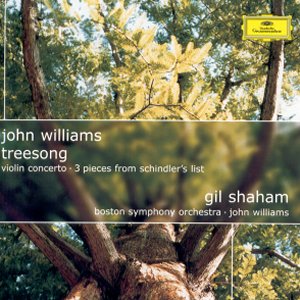Track Listing
Treesong (20:09)
(2000)
01. "Dr. Hu and the
Metasequoia", Dreamily (6:36)
02. "Trunks, Branches and Leaves", Twice as fast - Deciso (8:25)
03. "The Tree Sings", Tempo Primo (5:08)
Concerto for
Violin and Orchestra (30:08)
(1974-76, rev. 1998)
In Memory of B. R. W.
04. Moderato (11:01)
05. Slowly (In peaceful contemplation) (9:47)
06. Broadly (Maestoso) - Quickly (9:20)
Three Pieces from
Schindler's List (15:48)
(1993)
07. Theme, Lente (4:41)
08. Jewish Town (Krakow Ghetto - Winter '41), Andante (4:45)
09. Remembrances, Andante (6:22)
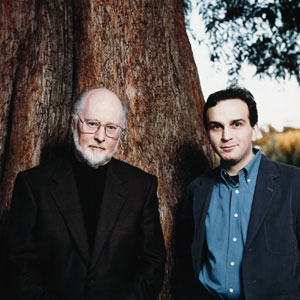
John Williams, Gil Shaham
For quite a few years it's
been my habit to walk in the Boston Public Garden as often as I can, and it has been
during these walks that I found myself stopping before a particular tree and pausing to
admire it.
The tree is a beautiful specimen of the Chinese dawn redwood, or metasequoia, and over
time my fascination with it grew into a full-fledged infatuation. I later learned that the
dawn redwood dates from the Mesozoic era, and until as recently as the 1940s it was
thought to be extinct. Fossils of its presence in the deep past did exist, but when live
specimens were discovered in China, the tree became referred to as the "living
fossil.” Standing before the tree one can sense its age and feel its wisdom.
I kept this affair of the heart very much to myself for several years until one day when I
was walking in Boston's Arnold Arboretum with Dr. Shiu-Ying Hu, the Harvard-based
botanist, to whom I'd been recently introduced. During our stroll we casually paused in
front of a large tree that I hadn't looked at closely enough to recognize immediately.
Pointing to the tree, Dr. Hu explained that this tree was the oldest metasequoia in North
America and that she had planted it in the late 1940s using seeds she had brought with her
from China. I was thunderstruck by this coincidence, and when I told her of "my”
metasequoia in the Public Garden, she informed me that the younger tree I loved so much
was also one of her children.
Recently, when I was given the opportunity to write a piece for Gil Shaham, I thought of
Dr. Hu and her tree. The result is TreeSong for violin and orchestra. The piece doesn't
aspire to "describe” the tree per se, but it does attempt, in my mind at least,
to connect, to the degree possible, the great beauty and dignity of this magnificent
conifer with the elegance and grace of Gil Shaham and his art.
John Williams
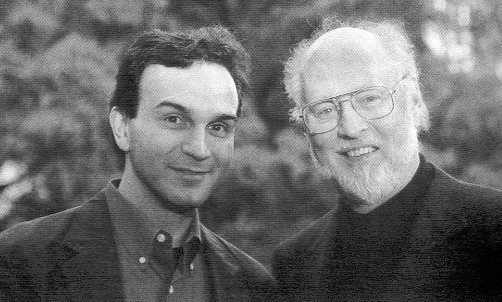
As composer and conductor, in the concert
hall and film, John Williams has long been recognized as one of the most versatile and
wide-ranging figures on the international musical scene. His multi-faceted achievements
reflect an all-embracing approach to music that goes back to the earliest years of his
career - as a student of the distinguished Italian composer Mario Castelnuovo-Tedesco in
Los Angeles and before that at the Juilliard School, where his teachers included the
legendary pianist Rosina Lhévinne. While studying in New York he also worked as a jazz
pianist in both clubs and on recordings.
This extraordinary breadth is manifested in such diverse areas as Williams's conducting
repertoire, his command of orchestration, and the various stylistic allusions in his music
(such as the Japanese shakuhachi flute tradition that forms the basis of his 1969 Flute
Concerto). A wide spectrum of influences and inspirations can be found in Williams's
compositions, not only purely musical ones, but also personal, spiritual, historical or
cinematic-dramatic, as in the celebrated film scores. Seven for Luck, an orchestral song
cycle on the poetry of Rita Dove, demonstrates his affinity for the written word.
Mythological and environmental concerns are at the heart of his bassoon concerto, The Five
Sacred Trees, which was inspired by ancient prayers recited before the felling of trees;
and a tree, of course, formed part of the inspiration for TreeSong. Williams's orchestral
work for Seiji! was both a tribute to the conductor Seiji Ozawa on the occasion of his
25th season as music director of the Boston Symphony Orchestra and a piece drawing on the
extraordinary acoustical qualities of Boston's Symphony Hall, with which Williams has had
long experience.
Williams's many collaborations - with other musicians as a pianist, with orchestras as a
conductor and composer, with film directors, and with the soloists in his concertos - are,
in a sense, an extension of this all-inclusive engagement with music and with the world
around him. Of his major symphonic works for the concert hall, a significant number
involve soloists - in addition to those for violin, bassoon and flute, there are concertos
for trumpet, tuba, cello and clarinet. Most of these were written with a particular player
in mind, among them the Cleveland Orchestra's principal trumpet Michael Sachs, cellist
Yo-Yo Ma, the Los Angeles Philharmonic clarinetist Michele Zukovsky, Boston Symphony
principal tuba Chester Schmitz, and New York Philharmonic bassoonist Judith LeClair in The
Five Sacred Trees. The composer's familiarity with the personality and musical strengths
of his performers has always guided the compositional process.
Gil Shaham and John Williams have collaborated as soloist and conductor for several years,
most notably with the Boston Symphony at Tanglewood, the orchestra's summer home in
western Massachusetts. This close working relationship, including performances of
Williams's Violin Concerto, developed into the great mutual admiration that led to
TreeSong and to the present recording. In a conversation with Williams, Shaham said of
these pieces, "For me, it's been the greatest joy to discover this new music. And as
much as I loved them on first hearing, the more I listen to them the more I find in them.
These pieces really speak to all people. That's a special quality of John Williams's
music.” Williams responded, "There is still nothing that speaks to the heart
like the violin. Invented hundreds of years ago in Italy, it's got enormous versatility,
including an agility in the soul of its sound that will continue to speak to generations
to come. For young people who may not yet have discovered the violin, Gil Shaham and his
highly communicative art would be a wonderful introduction.”
The origins of TreeSong are eloquently described in a note that John Williams wrote at the
time of the work's premiere at Tanglewood in July 2000, with its dedicatee, Gil Shaham, as
soloist and Williams conducting the Boston Symphony Orchestra. The extramusical
inspiration for TreeSong lends a "sylvan atmosphere” to the work, with a
delicate, shimmering orchestral backdrop to the solo part, suggesting the twilit interior
of a forest. The piece is not programmatic or specifically descriptive, however, and is
laid out in three movements like a traditional concerto, though with the usual
fast-slow-fast pattern inverted. The first movement, "Doctor Hu and the
Metasequoia,” marked "Dreamily,” opens with a gentle pulse (subtly
orchestrated with marimba, celesta, harp and piano) leading to the violin's entrance, the
first four notes of which serve as a motivic building block. The broad, chromatic
intervals and flexible phrasing immediately suggest the violin's potential, its singing
quality. A faster pulse and dancing motion suffuse the second movement, "Trunks,
Branches and Leaves,” in which the orchestra takes a more active role. After a
dramatic high point in the orchestra and a written-out cadenza, accompanied lightly or not
at all, the movement ends with a return to the dream-mood of the work's opening. The final
movement, "The Tree Sings,” is both a recapitulation and a culmination of the
piece's lyrical energy.
Williams began his Violin Concerto in 1974 and completed the orchestration in October
1976. Mark Peskanov was soloist in the first performance, on 19 January 1981, with the
Saint Louis Symphony Orchestra conducted by Leonard Slatkin. Williams subsequently revised
the work, which reached its present form in 1998. The score is dedicated to the composer's
late wife, the actress and singer Barbara Ruick Williams. Its general tone is not,
however, that of an elegy. Williams takes his cue from such 20th-century predecessors as
Bartók, Prokofiev, and Walton in writing a three-movement, post-Romantic concerto that
exploits the violin's historical and technical resources for the purpose of expressing
many different emotional perspectives. These range from the mysterious, almost haunting
opening theme, presented by the soloist nearly without accompaniment (the first few bars
over a pianissimo pedal E flat in the low strings), a second theme in the first movement
described by the composer as "jaunty,” and a scherzo-like figure in the finale
to a middle movement actually having the plaintive character of an elegy. Williams's
orchestration shifts kaleidoscopically, coloring, commenting upon, and supporting an
almost continuous solo part.
Like TreeSong, the Concerto exploits the violin's entire range. The work begins with a
melody for the soloist that covers more than two-and-a-half octaves in just a few
measures. Led by the flute, the orchestra then repeats the opening theme while the solo
violin accompanies with an active countermelody; this kind of give and take prevails
throughout the concerto. A propulsive second theme in 16th notes (semiquavers) lightens
the movement's palette. Williams has written out a solo cadenza, which occupies a
traditional position just prior to the quiet ending. This leads into the affecting second
movement (marked "in peaceful contemplation”), whose gently rocking orchestral
accompaniment foreshadows an almost frenetic passage later in the same movement. The
return to the main theme, taken by a solo flute with countermelody in the solo violin,
illustrates the composer's supple and finely detailed use of orchestration. The finale, a
nod to the traditional meshing of scherzo and rondo, begins with chiming, dissonant chords
juxtaposed with the rhythmically exultant solo part. This material returns again and
again, alternating with other themes and often laced with references to the first two
movements. A coda based on the fast scherzo-like music ends the work.
The music for Steven Spielberg's film Schindler's List represents yet another dialogue
with history. As Williams has commented, "I felt that Schindler's List was an
ennobling story taking place within the great tragedy of the Holocaust. The film offered
an opportunity to create not only dramatic music, but also themes that reflected the more
tender and nostalgic aspects of Jewish life during these turbulent years.” Thus the
three concert pieces drawn from the film score, originally recorded in September 1993 with
Itzhak Perlman accompanied by members of the Boston Symphony Orchestra, evoke the anguish
- tinged with poignant images of daily life - of central European Jewry during those
terrible times.
All of these pieces for violin and orchestra share the essential lyricism that infuses
Williams's music for the concert hall as well as for film, and which can be said to be at
the very heart of his compositional style. Other aspects of Williams's craft, such as his
acute dramatic sense and masterful handling of the orchestra, work in tandem with this
"singing” quality in the creation of deeply satisfying, fully realized musical
works. In the true spirit of collaboration, John Williams, Gil Shaham and the Boston
Symphony have come together in this recording, as they have many times before, for the
high purpose of hearing that music brought to life.
Robert Kirzinger
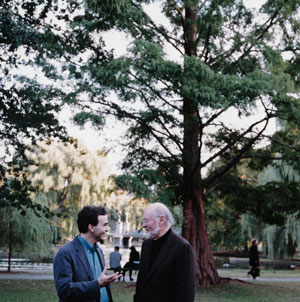
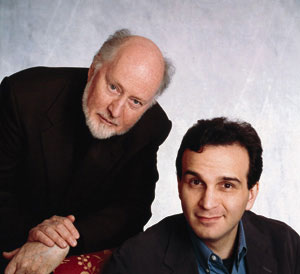
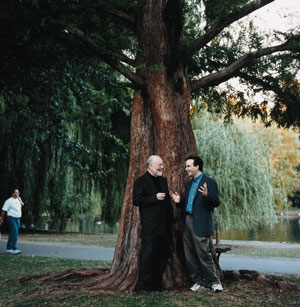
|
